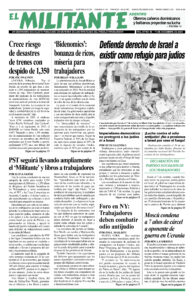Russian President Vladimir Putin is leading a drive to severely restrict women’s right to get an abortion in Russia, which in recent history has a relatively high abortion rate, an annual average of 46 per 1,000 women. At the same time, his government is seeking to limit aid to Russian families, as the pressures from Moscow’s genocidal war against the people of Ukraine is hitting increasingly hard on working people.
Putin and his cronies are dismayed by the plummeting birthrate in Russia. The rate of population decline has almost tripled since 2020. His war against Ukraine has so far resulted in a death toll of some 120,000 Russian soldiers, with 180,000 more wounded. Close to 1 million youth have left the country since the beginning of the war, seeking to avoid the draft and Putin’s deepening assault on political rights.
The Russian Revolution, led by V.I. Lenin and the Bolshevik Party, led to the decriminalization of abortion in 1920. This was just one part of the Bolsheviks’ drive to transform the situation facing women and working people, for society to take the burden of stultifying family chores off their backs. Their goal was to organize government services and aid that would free women to join in the revolutionary fight to transform Russian society. They also believed this course would make having a family far easier and make many abortions unnecessary. It was part of a broader campaign to advance women’s full legal equality with men.
This working-class-led struggle for women’s emancipation ground to a halt in Russia in the late 1920s. Following Lenin’s death in 1924, an increasingly counterrevolutionary layer in the Soviet government and Communist Party, led by Joseph Stalin, jettisoned the Bolsheviks’ policies. While defenders of Lenin’s course, led by Leon Trotsky, fought this, the isolation of the Russian Revolution aided Stalin’s triumph. The Stalinist bureaucracy rolled back gains won for women, oppressed nationalities and working people as a whole. As part of this Stalin outlawed virtually all abortions in 1936, seeking to increase the population.
After Stalin’s death abortion was once again legalized in 1955. They were legal, but under terrible conditions. The Stalinist rulers took no steps to provide safe, sanitary clinics, often leading to infection or infertility. Anesthesia was in short supply. Painkillers were scarce.
The Stalinist bureaucrats, with their eyes still fixated on the birthrate, also refused to develop safe, effective contraception. Women had little alternative but to use abortion as a method of birth control. The number of abortions jumped.
Today, Putin is driving to recriminalize abortion, to stamp it out as an option. In some regions, including occupied Crimea, Kaliningrad, Tatarstan and Chelyabinsk, private clinics have “voluntarily” stopped offering abortions. In May a proposal was introduced in the State Duma, Russia’s parliament, to remove abortion from the list of procedures covered by government-funded health insurance.
Russia’s republic of Mordovia was the country’s first region to criminalize the “coercion” of women “through persuasion, offers, bribery, deceit, or by imposing other demands” to have an abortion. In the Tver region, offenders can be held accountable even if a woman doesn’t actually get an abortion.
Mifepristone and misoprostol, used in “day after” abortion pills, are now considered controlled substances. Their availability is limited and their cost increasing. Sales of these emergency contraceptives soared 71% from 2022 to 2023, as women increasingly choose not to have babies during the Ukraine war.
The Russian Orthodox Church has joined in the regime’s vile propaganda campaign blaming women for Russia’s drop in population.
Billboards in some regions show two pictures side by side, one of a fetus, the other of a young boy in military uniform. “Protect me today,” the fetus says. “So that I can defend you tomorrow,” the child soldier says.
Putin has revived the “Mother Heroine” award, first introduced by Stalin in 1944 to try and boost births during the massive population losses of the Second World War. Qualifying mothers are awarded a payment of 1 million rubles ($11,000) after they give birth to 10 children and the 10th turns 1 year old.


